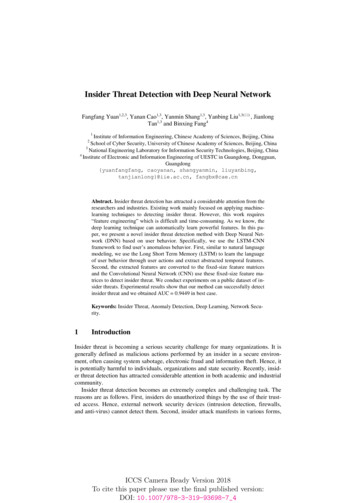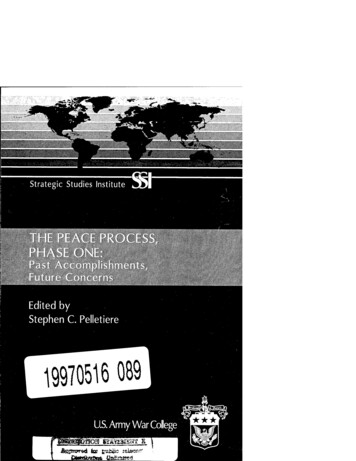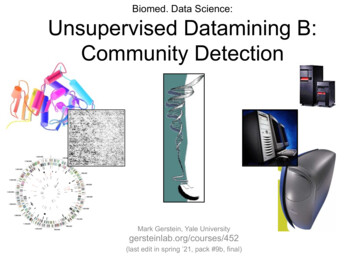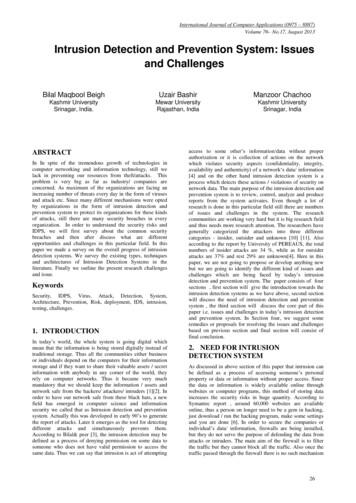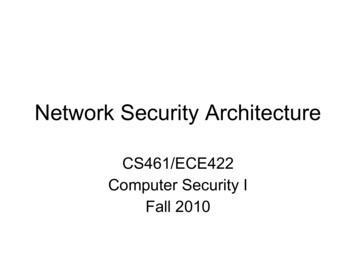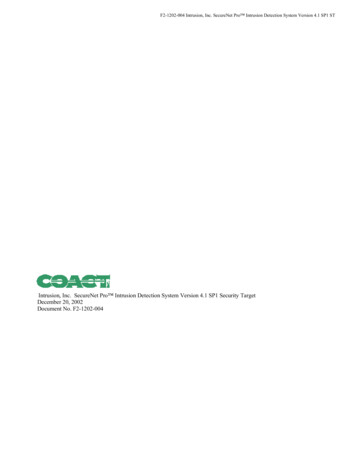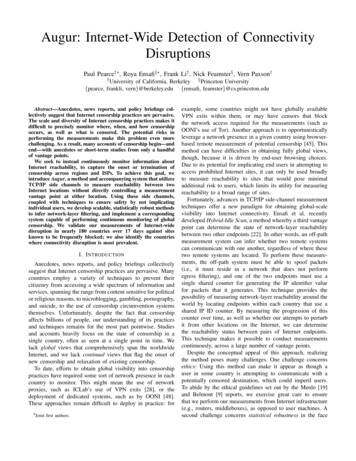
Transcription
Augur: Internet-Wide Detection of ConnectivityDisruptionsPaul Pearce† , Roya Ensafi§ , Frank Li† , Nick Feamster§ , Vern Paxson†† Universityof California, Berkeley § Princeton University{pearce, frankli, vern}@berkeley.edu {rensafi, feamster}@cs.princeton.eduAbstract—Anecdotes, news reports, and policy briefings collectively suggest that Internet censorship practices are pervasive.The scale and diversity of Internet censorship practices makes itdifficult to precisely monitor where, when, and how censorshipoccurs, as well as what is censored. The potential risks inperforming the measurements make this problem even morechallenging. As a result, many accounts of censorship begin—andend—with anecdotes or short-term studies from only a handfulof vantage points.We seek to instead continuously monitor information aboutInternet reachability, to capture the onset or termination ofcensorship across regions and ISPs. To achieve this goal, weintroduce Augur, a method and accompanying system that utilizesTCP/IP side channels to measure reachability between twoInternet locations without directly controlling a measurementvantage point at either location. Using these side channels,coupled with techniques to ensure safety by not implicatingindividual users, we develop scalable, statistically robust methodsto infer network-layer filtering, and implement a correspondingsystem capable of performing continuous monitoring of globalcensorship. We validate our measurements of Internet-widedisruption in nearly 180 countries over 17 days against sitesknown to be frequently blocked; we also identify the countrieswhere connectivity disruption is most prevalent.I. I NTRODUCTIONAnecdotes, news reports, and policy briefings collectivelysuggest that Internet censorship practices are pervasive. Manycountries employ a variety of techniques to prevent theircitizenry from accessing a wide spectrum of information andservices, spanning the range from content sensitive for politicalor religious reasons, to microblogging, gambling, pornography,and suicide, to the use of censorship circumvention systemsthemselves. Unfortunately, despite the fact that censorshipaffects billions of people, our understanding of its practicesand techniques remains for the most part pointwise. Studiesand accounts heavily focus on the state of censorship in asingle country, often as seen at a single point in time. Welack global views that comprehensively span the worldwideInternet, and we lack continual views that flag the onset ofnew censorship and relaxation of existing censorship.To date, efforts to obtain global visibility into censorshippractices have required some sort of network presence in eachcountry to monitor. This might mean the use of networkproxies, such as ICLab’s use of VPN exits [28], or thedeployment of dedicated systems, such as by OONI [48].These approaches remain difficult to deploy in practice: for Joint first authors.example, some countries might not have globally availableVPN exits within them, or may have censors that blockthe network access required for the measurements (such asOONI’s use of Tor). Another approach is to opportunisticallyleverage a network presence in a given country using browserbased remote measurement of potential censorship [45]. Thismethod can have difficulties in obtaining fully global views,though, because it is driven by end-user browsing choices.Due to its potential for implicating end users in attempting toaccess prohibited Internet sites, it can only be used broadlyto measure reachability to sites that would pose minimaladditional risk to users, which limits its utility for measuringreachability to a broad range of sites.Fortunately, advances in TCP/IP side-channel measurementtechniques offer a new paradigm for obtaining global-scalevisibility into Internet connectivity. Ensafi et al. recentlydeveloped Hybrid-Idle Scan, a method whereby a third vantagepoint can determine the state of network-layer reachabilitybetween two other endpoints [22]. In other words, an off-pathmeasurement system can infer whether two remote systemscan communicate with one another, regardless of where thesetwo remote systems are located. To perform these measurements, the off-path system must be able to spoof packets(i.e., it must reside in a network that does not performegress filtering), and one of the two endpoints must use asingle shared counter for generating the IP identifier valuefor packets that it generates. This technique provides thepossibility of measuring network-layer reachability around theworld by locating endpoints within each country that use ashared IP ID counter. By measuring the progression of thiscounter over time, as well as whether our attempts to perturbit from other locations on the Internet, we can determinethe reachability status between pairs of Internet endpoints.This technique makes it possible to conduct measurementscontinuously, across a large number of vantage points.Despite the conceptual appeal of this approach, realizingthe method poses many challenges. One challenge concernsethics: Using this method can make it appear as though auser in some country is attempting to communicate with apotentially censored destination, which could imperil users.To abide by the ethical guidelines set out by the Menlo [19]and Belmont [9] reports, we exercise great care to ensurethat we perform our measurements from Internet infrastructure(e.g., routers, middleboxes), as opposed to user machines. Asecond challenge concerns statistical robustness in the face
of unrelated network activity that could interfere with themeasurements, as well as other systematic errors concerningthe behavior of TCP/IP side channels that sometimes onlybecome apparent at scale. To address these challenges weintroduce Augur. To perform detection in the face of uncertainty, we model the IP ID increment over a time intervalas a random variable that we can condition on two differentpriors: with and without responses to our attempts to perturbthe counter from another remote Internet endpoint. Given thesetwo distributions, we can then apply statistical hypothesistesting based on maximum likelihood ratios.We validate our Augur measurements of Internet-wide disruption in nearly 180 countries over 17 days against both blocklists from other organizations as well as known IP addressesfor Tor bridges. We find that our results are consistent with theexpected filtering behavior from these sites. We also identifythe top countries that experience connectivity disruption; ourresults highlight many of the world’s most infamous censors.We begin in Section II with a discussion of related work.In Section III, we provide an overview of our method. Wepresent Augur in Section IV, introducing the principles behindusing IP ID side channels for third-party measurement of censorship; discussing how to identify remote systems that enableus to conduct our measurements in an ethically responsiblemanner; and delving into the extensive considerations requiredfor robust inference. In Section V, we present a concreteimplementation of Augur. In Section VI, we validate Augur’saccuracy and provide an accompanying analysis of globalcensorship practices observed during our measurement run.We offer thoughts related to further developing our approachin Section VII and conclude in Section VIII.II. R ELATED W ORKPrevious work spans several related areas. We begin witha discussion of closely related work on connectivity measurements using side channels. We then discuss previousresearch which has performed pointwise studies of censorshipin various countries, as well as tools that researchers havedeveloped to facilitate these direct measurements. Finally, wediscuss previous studies that have highlighted the variabilityand volatility of censorship measurements over time and acrossregions, which motivates our work.Measuring connectivity disruptions with side channels.Previous work has employed side channels to infer networkproperties such as topology, traffic usage, or firewall rulesbetween two remote hosts. Some of these techniques relyon the fact that the IP identifier (IP ID) field can revealnetwork interfaces that belong to the same Internet router, thenumber of packets that a device generates [13], or the blockingdirection of mail server ports for anti-spam purposes [43].The SYN backlog also provides another signal that helpswith the discovery of machines behind firewalls [23], [55].Ensafi et al. [22] observed that combining information fromthe TCP SYN backlog (which initiates retransmissions of SYNACK packets) with IP ID changes can reveal packet lossbetween two remote hosts, including the direction along thepath where packet drops occurred; the authors demonstratedthe utility of their technique by measuring the reachabilityof Tor relays from China [24]. Our work builds on thistechnique by developing robust statistical detection methods todisambiguate connectivity disruptions from other effects thatinduce signals in these side channels.Direct measurements from in-country vantage points. Researchers have performed many pointwise measurement studies that directly measure connectivity disruptions in countriesincluding China [5], [16], [56], Iran [7], Pakistan [33], [38],and Syria [12]. These studies have typically relied on obtainingvantage points in target countries, often by renting virtualprivate servers (VPSs) and performing measurements fromthat vantage point. These direct measurements have servedto reveal censorship mechanisms, including country-wide Internet outages [17], the injection of fake DNS replies [6],[34], the blocking of TCP/IP connections [53], HTTP-levelblocking [18], [30], [42], and traffic throttling [3]. In general,studies involving direct measurements can shed more light onspecific mechanisms that a censor might employ. By contrast,the techniques we develop rely on indirect side channels,which limits the types of measurements that we can perform.On the other hand, our approach permits a much larger scalethan any of these previous studies, as well as the ability toconduct measurements continuously. Although these studiesprovide valuable insights, their scale often involves a singlevantage point for a limited amount of time (typically no morethan a few weeks). Our aim is to shed light on a much broaderarray of Internet vantage points, continuously over time.Tools to facilitate direct measurements. OONI performsan ongoing set of censorship measurement tests from thevantage points of volunteer participants. It runs on bothpersonal machines and embedded devices such as RaspberryPis [26]. Although OONI performs a more comprehensiveset of tests than we can with our indirect measurement, thetool has deployment at a limited number of vantage points.CensMon [46] only runs on PlanetLab nodes, limiting itsvisibility to academic networks that can experience differentfiltering practices than residential or commercial networkswithin a country. UBICA [1] aimed to increase vantagepoints by running censorship measurement software on homegateway devices and user desktops. These systems requirepoints of contact within a country to establish and maintainthe infrastructure. The OpenNet Initiative [41] leverages socialconnections to people around the world to perform one-offcensorship measurements from home networks. As these measurements are collected opportunistically with no systematicbaseline, it can be difficult to draw consistent, repeatableconclusions.Studies that highlight the temporal and spatial variabilityof connectivity disruptions. If patterns of censorship andconnectivity disruptions hold relatively static, then existingone-off measurement studies would suffice to over time build
up a global picture of conditions. Previous work, however,has demonstrated that censorship practices vary across time;across different applications; and across regions and Internetservice providers, even within a single country. For example,previous research found that governments target a variety ofservices such as video portals (e.g., YouTube) [51], news sites(e.g., bbc.com) [8], and anonymity tools (e.g., Tor) [53].For example, Ensafi [21] showed that China’s Great Firewall (GFW) actively probes—and blocks upon confirmation—servers suspected to abet circumvention. Many studies showthat different countries employ different censorship mechanisms beyond IP address blocking to censor similar contentor applications, such as Tor [50]. Occasionally, countries alsodeploy new censorship technology shortly before significantpolitical events. For example Aryan [7] studied censorshipin Iran before and after the June 2013 presidential election.The observations of variable and volatile filtering practicesunderscore the need for our work, since none of the existingtechniques capture such variations.III. M ETHOD OVERVIEWIn this section, we provide an overview of the measurementmethod that we developed to detect filtering. We frame thedesign goals that we aim to achieve and the core techniqueunderlying our approach. Then in Section IV we provide adetailed explanation of the system’s operations.A. Design GoalsWe first present a high-level overview of the strategy underlying our method, which we base on inducing and observingpotential increments in an Internet host’s IP ID field. Thetechnique relies on causing one host on the Internet to sendtraffic to another (potentially blocked) Internet destination;thus, we also consider the ethics of the approach. Finally, wediscuss the details of the method, including how we select thespecific Internet endpoints used to conduct the measurements.Ultimately, the measurement system that we design shouldachieve the following properties: Scalable. Because filtering can vary across regions orISPs within a single country, the system must be ableto assess the state of filtering from a large number ofvantage points. Filtering will also vary across differentdestinations, so the system must also be able to measurefiltering to many potential endpoints. Efficient. Because filtering practices change over time, establishing regular baseline measurements is important, toexpose transient, short-term changes in filtering practices,such as those that might occur around political events. Sound. The technique should avoid false positives and ensure that repeated measurements of the same phenomenonproduce the same outcome. Ethical. The system design must satisfy the ethical principles from the Belmont [9] and Menlo [19] Reports:respect for people, beneficence, justice, and respect forlaw and public interest.We present a brief overview of the scanning method beforeexplaining how the approach satisfies the design goals above.B. ApproachThe strategy behind our method is to leverage the factthat when an Internet host generates and sends IP packets,each generated packet contains a 16-bit IP identifier (“IP ID”)value that is intended to assist endpoints in re-assemblingfragmented IPv4 packets. Although path MTU discovery nowlargely obviates the need for IP fragmentation, senders stillgenerate packets with IP ID values. There are only 216 uniqueIP ID values, but the intent is that subsequent packets fromthe same host should have different IP ID values.When an Internet host generates a packet, it must determinean IP ID to use for that packet. Although different hosts on theInternet use a variety of mechanisms to determine the IP IDfor each packet (e.g., random, counter-based increment perconnection or per-interface), many hosts use a single globalcounter to increment the IP ID value for all packets thatoriginate from that host, regardless of whether the packetsit generates bear a relationship to one another. In these caseswhere the host uses a single IP ID counter, the value of thecounter at any time reflects how many packets the host hasgenerated. Thus, the ability to observe this counter over timegives an indication of whether a host is generating IP packets,and how many.The basic method involves two mechanisms: Probing: A mechanism to observe the IP ID value of ahost at any time. Perturbation: A mechanism to send traffic to that samehost from different Internet destinations, which has theproperty of inducing the initial host to respond, thusincrementing its IP ID counter.We now describe the basic design for probing and perturbation,in the absence of various complicating factors such as crosstraffic or packet loss. Figure 1 illustrates the process.To probe the IP ID value of some host over time, a measurement machine sends unsolicited TCP SYN-ACK packetsto the host and monitors the responses—TCP RST packets—to track the evolution of the host’s IP ID. We monitor theIP ID values at the host on one end of the path. We call thishost the reflector, to denote that the host reflects RST packetsfrom both our measurement machine and the endpoint that acensor may be trying to filter. This reflector is a machine ina network that may experience IP filtering. We call the otherendpoint of this connection the site, as for our purposes wewill commonly use for it a website operating on port 80.To perturb the IP ID values on either end of the path, ameasurement machine sends a TCP SYN packet to one host,the site; the TCP SYN packet carries the (spoofed) sourceIP address of a second machine, the reflector. We term thisinjection. If no filtering is taking place, the SYN packet fromthe measurement machine to the site will elicit a SYN-ACKfrom the site to the reflector, which will in turn elicit a RSTfrom the reflector to the site (since the reflector had notpreviously sent a TCP SYN packet for this connection). Whenthe reflector sends a RST packet to the site, it uses a new IP ID.If the reflector generates IP ID values for packets based on a
5SYN-ACK33TsTSYN-ACKsTIPID(t1) 6IPID(t4) 8IPID(t6) 10FREFFRESpoSYN ofedKInbound Blocking2CKMeasurementMachineC-ANo Direction BlockedIPID(t1) 6IPID(t4) 71-AKC-AMeasurementMachine4NSYCKSpoSYN ofed2-ANSYKIPID(t1) 6IPID(t4) 81NSY4NSYCKC-ANSY-ANSY2RE14SpoSYN ofedTRSRSRSTRSRSMeasurementMachineOutbound BlockingFig. 1: Overview of the basic method of probing and perturbing the IP ID side channel to identify filtering. Reflectors arehosts on the Internet with a global IP ID. Sites are potentially filtered hosts that respond to SYN packets on port 80. (In theright hand figure, we omit subsequent measuring of the reflector’s IP ID by the measurement machine at time t6 ). SpoofedSYN packets have a source field set to the reflector.single counter, the measurement machine can observe whetherthe reflector generated a RST packet with subsequent probes,because the IP ID counter will have incremented by two (onefor the RST to the site, one for the RST to our measurementmachine). Figure 1 shows this process in the “no directionblocked” scenario.Suppose that filtering takes place on the path between thesite and the reflector (i.e., one of the other two cases shown inFigure 1). We term blocking that manifests on the path fromthe site to the reflector as inbound blocking. In the case ofinbound blocking, the site’s SYN-ACK packet will not reachthe origin, thus preventing the expected IP ID increment atthe reflector. In the absence of other traffic, the IP ID counterwill increment by one. We show this in the second section ofFigure 1.Conversely, we call blocking on the path from the reflectorto the site outbound blocking; in the case of outbound blocking, SYN-ACK packets from the site reach the reflector, but theRST packets from the reflector to the site never reach the site.At this point, the site should continue to retransmit SYN-ACKpackets [49], inducing further increments in the IP ID valueat the reflector at various intervals, though whether and how itactually does so depends on the configuration and specifics ofthe site’s operating system. The final section of Figure 1 showsthe retransmission of SYN-ACK packets and the increment ofthe global IP ID at two different times. If our measurementsreveal a site as inbound-blocked, filtering may actually bebidirectional. We cannot differentiating between the two usingthis technique because there is no way to remotely induce thereflector to send packets to the site.C. EthicsThe measurement method we develop generates spoofedtraffic between the reflector and the site which might causean inexperienced observer of these measurements to (wrongly)conclude that the person who operates or owns the reflectorwas willfully accessing the site. The risks of this type ofactivity are unknown, but are likely to vary by country.Although the spoofed nature of the traffic is similar to commonlarge-scale denial-of-service backscatter [37] and results in nodata packets being exchanged between reflector and site, wenonetheless use extreme caution when selecting each reflector.In this type of measurement, we must first consider respectfor humans, by limiting the potential harm to any personas a result of this experiment. One mechanism for demonstrating respect for humans is to obtain informed consent;unfortunately, obtaining informed consent is difficult, due tothe scope, scale, and expanse of the infrastructure that weemploy.Salganik explains that the inability to obtain informedconsent does not by itself reflect a disregard of respect forhumans [44]. Rather, we must take other appropriate measuresto ensure that we are abiding by the ethical principles fromthe Belmont [9] and Menlo [19] reports. To do so, we developa method that reduces the likelihood that we are directlyinvolving any humans in our experiments in the first place, byfocusing our measurements on infrastructure. Specifically, ourmethod works to limit the endpoints that we use as reflectorsto likely Internet infrastructure (e.g., routers in the accessor transit networks, middleboxes), as opposed to hosts thatbelong to individual citizens (e.g., laptops, desktops, homerouters, consumer devices). To do so, we use the CAIDAArk dataset [11], which contains traceroute measurementsto all routed /24 networks. We include a reflector in ourexperiments only if it appears in an Ark traceroute at leasttwo hops away from the traceroute endpoint. The Ark datasetis not comprehensive, as the traceroute measurements areconducted to a randomly selected IP address in each /24 prefix.Restricting the set of infrastructure devices to those that appearin Ark restricts the IP addresses we might be able to discoverwith a more comprehensive scan.Although this approach increases the likelihood that thereflector IP addresses are routers or middleboxes as opposedto endpoints, the method is not fool-proof. For example,devices that are attributable to individuals might still be twohops from the network edge, or a network operator might
be held accountable for the perceived actions performed bythe machines. Our techniques do not eliminate risk. Rather,in accordance with the ethical guideline of beneficence, theyreduce it to the point where the benefits of collecting thesemeasurements may outweigh the risks of collecting them. Inkeeping with Salganik’s recommendations [44], we aim toconduct measurements that pose a minimal additional risk,given both the nature of the spoofed packets and the potentialbenefits of the research.The Internet-wide scans we conduct using ZMap [20] todetect possible reflectors introduce concerns related to respectfor law and public interest. Part of the respect of law andpublic interest is to reduce the network load we induce onreflectors and sites, to the extent possible, as unnecessarynetwork load could drive costs higher for the operators ofreflectors and sites; if excessive, the probing traffic couldalso impede network performance. To mitigate these possibleeffects, we follow the approach for ethical scanning behavioras outlined by Durumeric et al. [20]: we signal the benignintent of our scans in the WHOIS entries and DNS recordsfor our scanning IPs, and provide project details on a websitehosted on each scanning machine. We extensively tested ourscanning methods prior to their deployment; we also respectopt-out requests.The measurement probes and perturbations raise similarconcerns pertaining to respect for law and public interest. Wedefer the details of the measurement approach to Section IVbut note that reflectors and sites receive an average of onepacket per second, with a maximum rate of ten SYN packetsin a one-second interval. This load should be reasonable, giventhat reflectors represent Internet infrastructure that should beable to sustain modest traffic rates directed to them, and sitesare major websites that see much higher traffic rates than thosewe are sending. To ensure that our TCP connection attempts donot use excessive resources on sites or reflectors, we promptlyreset any half-open TCP connections that we establish.The ethical principle of justice states that the parties bearingthe risk should be the same as those reaping the benefits; theparties who would bear the risk (users in the countries wherecensorship is taking place) may ultimately reap some benefitfrom the knowledge about filtering that our tools providethrough improved circumvention tools and better informationabout what is blocked.IV. AUGUR : P UTTING THE M ETHOD TO P RACTICEIn this section, we present our approach for identifyingreflectors and sites, and then develop in detail how we performthe measurements described in Section III.A. Reflector RequirementsSuitable reflectors must satisfy four requirements:1) Infrastructure machine. To satisfy the ethical guidelines that we outlined in Section III-C, the reflectorshould be Internet infrastructure, as opposed to a usermachine.2) RST packet generation. Reflectors must generate TCPRST packets when receiving SYN-ACKs for unestablished connections. The RST packets increment thereflector’s IP ID counter while ensuring that the siteterminates the connection.3) Shared, monotonically incrementing IP ID. If a reflector uses a shared, monotonic strictly increasing permachine counter to generate IP ID values for packetsthat it sends, the evolution of the IP ID value—whichthe measurement machine can observe—will reflect anycommunication between the reflector and any otherInternet endpoints.4) Measurable IP ID perturbations. Because the IP IDfield is only 16 bits, the reflector must not generate somuch traffic so as to cause the counter value to frequently wrap around between successive measurementmachine probes. The natural variations of the IP IDcounter must also be small compared to the magnitudeof the perturbations that we induce.Section V describes how we identify reflectors that meet theserequirements.B. Site RequirementsOur method also requires that sites exhibit certain networkproperties, allowing for robust measurements at reflectorsacross the Internet. Unlike reflectors, site requirements are notabsolute. In some circumstances, failure to meet a requirementrequires discarding of a result, or limits possible outcomes, butwe can still use the site for some measurements.1) SYN-ACK retransmission (SAR). SYN-ACK retriesby sites can signal outbound blocking due to a reflector’s RST packets not reaching the site. If a sitedoes not retransmit SYN-ACKs, we can still detectinbound blocking, but we cannot distinguish instancesof outbound blocking from cases where there is noblocking.2) No anycast. If a site’s IP address is anycast, the measurement machine and reflector may be communicatingwith different sites; in this case, RSTs from the reflectorwill not reach the site that our measurement machinecommunicates with, which would result in successiveSYN-ACK retransmissions from the site and thus falselyindicate outbound blocking.3) No ingress filtering. If a site’s network performs ingressfiltering, spoofed SYN packets from the measurementmachine may be filtered if they arrive from an unexpected ingress, falsely indicating inbound blocking.4) No stateful firewalls or network-specific blocking. Ifa site host or its network deploys a distributed stateful firewall, the measurement machine’s SYN packetmay establish state at a different firewall than the oneencountered by a reflector’s RSTs, thus causing thefirewall to drop the RSTs. This effect would falselyindicate outbound blocking. Additionally, if a site or itsfirewall drops traffic from some IP address ranges but not
others (e.g., from non-local reflectors), the measurementmachine may falsely detect blocking.Section V-E describes how we identify sites that satisfy theserequirements.C. Detecting DisruptionsAs discussed in Section III, we detect connectivity disruptions by perturbing the IP ID counter at the reflectorand observing how this value evolves with and without ourperturbation.Approach: Statistical detection. We measure the naturalevolution of a reflector’s counter periodically in the absenceof perturbation as a control that we can compare against theevolution of the IP ID under perturbation. We then perturb theIP ID counter by injecting SYN packets and subsequently measure the evolution of this counter. We take care not to involveany site or reflector in multiple simultaneous measurements,since doing so could conflate two distinct results.Ultimately, we are interested in detecting whether the IP IDevolution for a reflector changes as a result of the perturbationswe introduce. We can represent this question as a classicalproblem in statistical detection, which attempts to detectthe presence or absence of a prior (i.e., perturbation or noperturbation), based on the separation of the distributionsunder different values of the prior. In designing this detectionmethod, we must determine the random variable whose distribution we wish to measure, as well as the specific detectionapproach that allows us to distinguish the two values of theprior with confidence. We choose IP ID acceleration (i.e., thesecond derivative of IP ID between successive measurements)as ideally this value has a
proxies, such as ICLab's use of VPN exits [28], or the deployment of dedicated systems, such as by OONI [48]. These approaches remain difficult to deploy in practice: for second challenge concernsJoint first authors. example, some countries might not have globally available VPN exits within them, or may have censors that block
